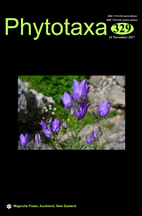Abstract
Presliophytum is a small genus of five species endemic to arid western South America, including coastal Peru and the Atacama Desert. The type species, Presliophytum incanum, was originally described in Loasa, but recognized as highly distinctive and placed into a monotypic section in the late 19th century. Together with Loasa heucheraefolia and a newly described species, it was placed into the genus Presliophytum in 1997. Subsequent molecular studies confirmed the monophyly of the genus and indicated a close relationship to two Chilean species, traditionally placed in Loasa series Malesherbioideae, a placement formalized in 2017 by providing the necessary new combinations. However, a detailed revision and description of the taxon has not been provided and the present study aims at filling this gap. We provide data on the morphology and micromorphology, distribution and ecology of the five species, as well as a key for all the species. Presliphytum incanum is the most common and widespread species, but also morphologically the most variable. There are differences in leaf and flower morphology between northern and southern populations, but these are difficult to discern in herbarium specimens. The species is therefore here maintained in the broader sense, since at present it seems impossible to clearly differentiate two morphologically discrete entities.

